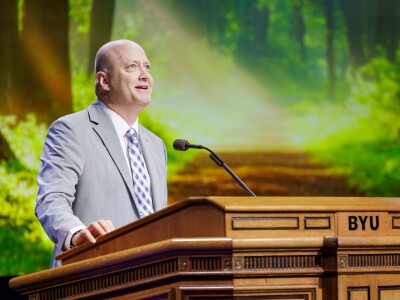Using patented technology just licensed from Brigham Young University, a Utah start-up can build a wide range of lighter weight structures having extraordinary strength, including giant wind turbine towers. Such breakthrough towers would deliver three times more electric power than current turbines hindered by today's technological limitations and at markedly lower cost.
PYRAmatrix Structures, Inc., a company founded by the corporate development firm Wasatch Valley Technologies, has been granted the exclusive United States license to commercialize BYU's lighter-weight composite structure technology able to support burdens twelve times heavier than the maximum capacity of steel structures weighing the same amount.
"PYRAmatrix TM is the world's first advanced composite structure configured in a lattice geometry. This makes PYRAmatrix the lightest, strongest, most efficient structure available," said Jerral R. Pulley, chairman of Wasatch Valley Technologies and former senior executive of Pepsico, Squibb, Borden and Ryder System. "Put next to a metal or ordinary composite structure with equivalent load-bearing capability, PYRAmatrix will always weigh dramatically less and, for many applications, cost less to make."
PYRAmatrix, made from carbon fiber, fiberglass or a combination, utilizes patented geometric technology that optimizes the inherent strength of reinforcing pyramids and triangles, thereby requiring less high-cost fiber material. For example, a 47-foot long PYRAmatrix cylinder, 16 inches in diameter and weighing just 47 pounds, can support almost 4 tons - almost 200 times its own weight.
PYRAmatrix delivers the same strength characteristics of comparable metal or ordinary composite forms, but PYRAmatrix is only 9 percent the weight of steel and 24 percent the weight of aluminum. Even more dramatic, compared to expensive conventional composites, PYRAmatrix is 26 percent of the weight and up to 50 percent lower in price.
The company has identified a host of promising additional applications where lighter- weight strength is critical: construction tilt wall braces, electric utility transmission and distribution towers, large over-the-road truck trailers, radar towers, communication towers, airplanes, outer space applications and oil drilling platforms. Recreational applications include: bicycles, motorcycles, ATVs, snowmobiles, motor boats, sail boat masts, recreational aircraft and sports gear racks for vehicles.
PYRAmatrix also has great design flexibility and can be made from virtually any combination of resin and fiber materials in products from 3 inches to more than 20 feet in diameter and in lengths up to 300 feet.
The technology was developed by David W. Jensen, professor of civil engineering, at BYU's Center for Advanced Structural Composites, part of the state of Utah's Centers of Excellence program. Twelve of Jensen's graduate students have studied the PYRAmatrix for their master's theses, and about a dozen undergraduates also contributed to its development. Jensen has also published many scholarly articles in engineering journals about his team's research advances.
"Signing the licensing agreement has been the most exciting part of the process because it means this technology is being commercialized for real-world applications," said Jensen, who earned his doctorate in engineering from the Massachusetts Institute of Technology. Jensen is also a consultant to the company and believes the license "opens the door to a lifetime of research into improvements and enhancements of the technology."
J. Tracy Livingston, a partner in Wasatch Valley Technologies and PYRAmatrix's Chief Technology Officer, has studied performance characteristics and researched markets for promising applications, including large electric utility poles, communication towers and wind turbines.
"It is becoming more and more difficult to obtain long-length, wood poles," Livingston said. "We have a product that is not only competitive in load-bearing performance with increasingly expensive taller wood poles and large steel transmission towers, but is also lower in price."
As ubiquitous as electric transmission poles are, Livingston is also excited about large wind turbines that generate electricity. This was one of the fastest growing markets in the U.S. last year, he noted, and is forecast to grow at double-digit rates annually for the next decade.
"These turbines are 200-plus feet tall, with 250,000-pound turbine heads on top and generate 1.5 megawatts each," Livingston said. "The steel tower they use to set this turbine head on weighs more than 300,000 pounds. It is difficult to get to the job site, enormously expensive to transport and expensive to install. We have submitted a design to the Department of Energy to replace those heavy steel towers with PYRAmatrix. Our PYRamatrix tower will weigh only 10,000 pounds, have the same load-bearing capacity and cost significantly less to transport and install."
Livingston ultimately wants to help the renewable energy industry meet the need to build cost-effective, five-megawatt turbines. The steel tower to support turbines that large would "weigh more than one million pounds and cost about $1 million to get to the site. It will cost only $30,000 to get the PYRAmatrix tower to the site."
Pulley and Livingston, along with their partner Christopher Derrington, CEO of Wasatch Valley Technologies and PYRAmatrix Structures, Inc., combed through 100 ideas and technologies for a year before choosing BYU's structural technology, known as the IsoTruss, as their partnership's first venture.
"BYU's technology transfer office had gone the extra mile and conducted research and analysis to define potential applications for this technology," Derrington said. "Their homework made our due diligence much easier. We are delighted that PYRAmatrix now has the exclusive license to commercialize this technology throughout the United States."
Derrington and his colleagues are now focused on taking the BYU laboratory processes to the commercial level to provide highest quality and cost effective large-scale production.
Specific terms of BYU's agreement with Wasatch Valley Technologies were not disclosed.
In addition to funding from the state of Utah, Jensen's lab received grants from NASA, the Federal Highway Administration and the National Science Foundation.
For more information, visit and





